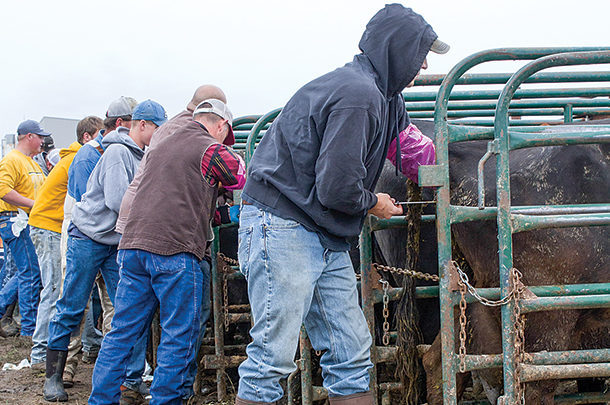At the same time, A.I. is often thought of as complex and hard to implement. But it doesn’t have to be that way – you can make it as simple as your situation calls for.
A.I. also offers herd management improvements, including:
- Lower cost per breeding
- Easy-to-achieve, three-way crossbreeding programs to capitalize on hybrid vigor
- A.I. protocol shots can be timed to coincide with when a herd’s calves are first vaccinated, maximizing the labor inputs to manage your cow herds
- A tightened calving window can result in less time spent checking cattle at calving
When it comes to breeding, you have a few options. You can hire an A.I. specialist to do all of the breeding for you. But you also have to pay for the service, and service is provided as it fits into the specialist’s schedule. Participating in an A.I. breeding school might be a better alternative if you are breeding smaller numbers of cattle, such as herds of 50 head or fewer. Many extension programs offer these schools, or there are privately available courses.
If you are doing the breeding, you don’t need a lot of equipment. You can run cattle through the same facilities you would do routine vaccinations. A.I. equipment can be as simple as:
- An A.I. gun (around $30)
- Sheaths for the A.I. gun
- A thermos to thaw out straws of semen (around $5)
- A pair of scissors
- Obstetrical gloves
- Paper towels
With a little bit of training and a small investment in equipment, you can make significant strides in advancing herd genetics and overall management.
Here are some strategies to consider as you get started with A.I.:
Start with heifers
The most manageable group to start an A.I. program on are your replacement heifers, since they don’t have calves at side like cows do during the breeding season.
Depending on herd management, you could A.I. heifers a cycle earlier than the rest of the cow herd, allowing them another opportunity to breed during the next cycle. Breeding heifers to calve earlier gives them more time to recover post-calving and be ready to rebreed the subsequent breeding season.
Detecting heat
There are several fixed-timed A.I. protocols, but the timing of estrus varies depending on the breeding program. If you want the best conception rates consistently, you must breed cows and heifers that are in estrus. Heat detection is the primary way to determine when females are in estrus.
You have the option to watch for standing estrus to occur. However, this process takes up a lot of time when no visual aids are used.
Adhesive breeding indicator patches can help visually show when cows or heifers are in estrus. The patches are applied between the hip and tailhead. As mounting activity occurs, the breeding indicator’s surface ink is rubbed off to expose a bright indicator color. With breeding indicators, you can monitor estrus activity as you have time and get a quick visual representation of cows ready for breeding.
A recent study I was involved with analyzed more than 10,000 animals that were bred using fixed-timed A.I. Cows and heifers that exhibited estrus prior to fixed-time A.I. as determined with breeding indicator patches had a 27% improvement in conception rates versus those females not showing estrus prior to fixed-time A.I.
Breeding when cattle are in estrus with the help of a visual aid, like an adhesive breeding indicator patch, ensures cows are responded to quickly and that your breeding protocols work properly.
Weekend breeding
A set of heifers or cows can be bred effectively during a three-day weekend when synchronization protocols are timed correctly. Using breeding indicators to help spot when cattle are in heat makes the process even more efficient.
If you’re just getting started, a cost-effective way to implement this strategy is to breed from a dry shipper cooler filled with semen and delivered to the farm. The dry shipper method saves on the cost of renting or buying a semen tank, and there is no liquid nitrogen to purchase. Semen dealers are usually happy to offer these services, and you just have to return the cooler back.
Ideally, the semen shipment arrives to the farm on Thursday. Then you heat detect and breed on Friday through Sunday. These semen shippers usually will stay cold and keep semen viable for about a week.
With quality nutrition and health programs, conception rates for first-service A.I. can range from 60% to 65% during three-day breeding timelines. In ideal programs, you could achieve 70% or higher.
A system like this can work well for cattle producers who aim to have a tighter calving window and a more uniform calf crop.
Work with your veterinarian, extension specialist or genetics provider to develop the A.I. program that will work best for your herd. ![]()
PHOTO: Students of various ages and skill levels participated in South Dakota State University’s A.I. breeding school last year. Photo by Wendy Sweeter.

-
George A. Perry
- Beef Reproduction Management
- South Dakota State University
- Email George A. Perry










